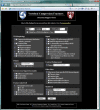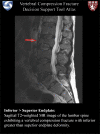An online evidence-based decision support system for distinguishing benign from malignant vertebral compression fractures by magnetic resonance imaging feature analysis
- PMID: 20680384
- PMCID: PMC3092053
- DOI: 10.1007/s10278-010-9316-3
An online evidence-based decision support system for distinguishing benign from malignant vertebral compression fractures by magnetic resonance imaging feature analysis
Erratum in
- J Digit Imaging. 2011 Aug;24(4):561. Thawait, Shrey [corrected to Thawait, Shrey K]
Abstract
Decision support systems have been used to promote the practice of evidence-based medicine. Computer-assisted diagnosis can serve as one element of evidence-based radiology. One area where such tools may provide benefit is analysis of vertebral compression fractures (VCFs), which can be a challenge in MRI interpretation. VCFs may be benign or malignant in etiology, and several MRI features may help to make this important distinction. We describe a web-based decision support system for discriminating benign from malignant VCFs as a prototype for a more general diagnostic decision support framework for radiologists. The system has three components: a feature checklist with an image gallery derived from proven reference cases, a prediction model, and a reporting mechanism. The website allows users to input the findings for a case to be interpreted using a structured feature checklist. The image gallery complements the checklist, for clarity and training purposes. The input from the checklist is then used to calculate the likelihood of malignancy by a logistic regression prediction model. Standardized report text is generated that summarizes pertinent positive and negative findings. This computer-assisted diagnosis system demonstrates the integration of three areas where diagnostic decision support can aid radiologists: first, in image interpretation, through feature checklists and illustrative image galleries; second, in feature-based prediction modeling; and third, in structured reporting. We present a diagnostic decision support tool that provides radiologists with evidence-based guidance for discriminating benign from malignant VCF. This model may be useful in other difficult-diagnosis situations and requires further clinical testing.
Figures





References
-
- Hunt DL, Haynes RB, Hayward RSA, Pim MA, Horsman J. Patient-specific evidence-based care recommendations for diabetes mellitus: development and initial clinic experience with a computerized decision support system. Int J Med Inform. 1998;51:127–135. doi: 10.1016/S1386-5056(98)00110-5. - DOI - PubMed
Publication types
MeSH terms
LinkOut - more resources
Full Text Sources
Medical

